In his book Outliers, Malcolm Gladwell asserts that it takes 10,000 hours of practice for a person to become an 'expert' at something. When we see international batsmen play, they are using techniques crafted through hours of practice. Their movements in the time between the bowler releasing the ball and it reaching them is therefore not a split-second decision, but the result of countless decisions made over the years.

However, once every few years, these batsmen come across a bowler capable of unraveling tens of thousands of hours of practice.
This article examines ten of the greatest Test series an individual bowler has ever had, a series during which a single bowler dominated an entire batting unit. Their inclusion on this list, and indeed their ranking, is dependent on several factors. Their figures throughout the series in question is, of course, the starting point, but other factors such as the quality of opposition they faced, and the context in which they faced them is also considered.
So, certain individual performances, while statistically phenomenal, don't quite make the list. For example, Sydney Barnes' remarkable 1913/14 tour of South Africa fails to make the cut despite Barnes taking 49 wickets in the series, the most by any bowler in cricketing history. This is because he was playing a very weak South African side on favorable pitches.
Muttiah Muralitharan, on four occasions, managed to take 26 wickets in a three-match series. While this list does contain some three-match series, it generally favors longer tours as these allow the bowlers to demonstrate their supremacy over the opposition for a prolonged period. This puts certain bowlers at a disadvantage as some nations tend to play longer series than others.
#10 Mike Procter: 26 wickets at 13.58 vs Australia (1970)
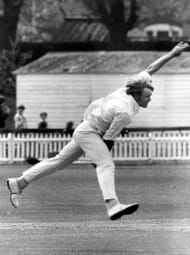
Australia's 1970 tour of South Africa would turn out to be the last Test series South Africa would participate in for over 20 years as apartheid saw them banned from international cricket.
This curtailed the international careers of some truly brilliant players as the South African side that played this series was arguably one of the greatest test sides in history. Among their ranks were the likes of Graeme and Peter Pollock, Eddie Barlow, Barry Richards, Denis Lindsay and Mike Procter.
Procter was an all-rounder on the level of Ian Botham, Kapil Dev, Richard Hadlee and Imran Khan, all who would make their Test debuts later in the decade. But while these players were dazzling the world on the international stage, Procter was confined to domestic cricket. Nevertheless Procter still showed his immense talent, averaging 36.01 with the bat and just 19.53 with the ball across 401 first-class games.
The 1970s series against Australia therefore provided a taste of Procter's skill as he humiliated an Australian side that included batsmen such as Doug Walters, Bill Lawry, Ian Chappell and Keith Stackpole.
Australia's best batsmen during the series was Ian Redpath and even he was dismissed by Procter on five occasions.
This included the final innings of the series at Port Elizabeth. Here Australia were set the highly improbable target of 570 after Barry Richards and Brian Irvine had ground the Australian bowlers to dust with classy centuries. But not all went South Africa's way as Peter Pollock was only able to deliver one full over before succumbing to injury. Procter picked up much of the slack from his new-ball partner and finished with 6/73.
This was the only five-for Procter took in the series, as he didn't so much decimate the Australian batsmen as he did consistently show his superiority.
Procter showed the best of what South Africa had to offer, but the worst his country had to offer prevented him from showing more.
#9 Glenn McGrath: 30 wickets at 16.93 vs the West Indies (1999)
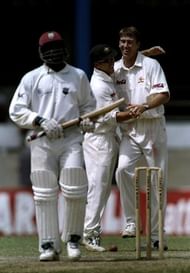
McGrath's Test bowling record is virtually without blemish. His consistency and longevity meant he had success against every Test-playing nation and didn't average above 30 against a single side.
Even then, he favored certain opposition. He was particularly potent against England and the West Indies, taking over 100 wickets against both sides. McGrath had numerous great series against these two sides. He helped Australia win a series against the West Indies for the first time in nearly 20 years in 1995, then helped them retain it with another excellent series the following year. He was brilliant in his first tour of England in 1997, and was arguably the best bowler in the following two Ashes series as well. However, never was McGrath better than in the four-match series against the West Indies in 1999.
The years prior to this series had signified a shift in the balance of power. The West Indies had been the strongest side in cricket since the mid to late seventies, but as the 90s wore on Australia began to steal this title from them. The 1995 series between the two sides can be viewed as the moment Australia supplanted the West Indies as the world's best team even though the West Indies still had an excellent side for some years afterwards.
The 1999 series was proof of this. It was a thoroughly entertaining spectacle between two great sides and in the end it was tied two all with Australia retaining the Frank-Worrell trophy and McGrath playing a vital role in ensuring this was the case.
McGrath took four five-wicket hauls in the series, outshining the likes of Courtney Walsh and Curtly Ambrose. His value to the side was identified by Steve Waugh, who bowled him 199.4 overs across the series, more than 80 overs more than the next Australian.
13 of his 30 wickets were leg before, highlighting McGrath's mastery of stump-to-stump bowling.
The series turned out to be the last time the West Indies would truly challenge Australia, but without McGrath they may well have won.
#8 Ravichandran Ashwin: 31 wickets at 11.13 vs South Africa (2015)
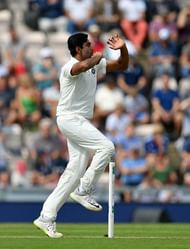
Heading into the 2015 series in India, South Africa were an exception in being a side that had actually found success in India. They had drawn their last two series there, showing the fighting spirit for which South African cricket had become renown. While the South African teams from the late 2000s and early 2010s did not dominate sides like the great Australian and West Indian teams before them, they had earned their status as the best Test side in the world by being notoriously difficult to beat. In fact, heading into the 2015 series against India, they had lost only two of their last 30 series, and had not lost an away series since 2006.
However, their four-match series in India saw them treated to a spin masterclass as Ashwin and Ravindra Jadeja tore apart what had been one of the most reliable batting sides in recent years.
In their seven innings throughout the series, South Africa never scored more than 214 runs, which was remarkable for a side that included AB de Villiers, Hashim Amla and Faf du Plessis.
Many of their woes can be attributed to them facing Ashwin while the off-spinner was in the middle of a brilliant run of form. From the start of 2015 to the end of 2016, he would take five 10-wicket hauls. Excluding Ashwin himself, only 10 other bowlers have had more 10 wicket hauls in their entire career.
The pitches may have been favorable to spin bowling, but Ashwin averaged nearly half of what Imran Tahir did for the series and less than half of what Simon Harper managed, showing he exploited conditions far better than his counterparts.
At times Ashwin was as close to as unplayable as a bowler in modern conditions could be. Stiaan van Zyl can attest to this as he was dismissed by Ahswin in all of the five innings he played in the series.
Over the decade preceding this series, South Africa rarely lost a game and almost never lost a series. Ashwin's dominance over the four matches didn't only secure a series win, but ended perhaps the most successful era in South African cricketing history.
#7 Terry Alderman: 41 wickets at 17.37 vs England (1989)
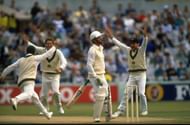
Terry Alderman had a strange career. Possibly the last genuine swing bowler Australia produced, Alderman took 100 of his 170 Test wickets against England. Furthermore, 83 of those wickets were taken in England despite Alderman only touring there twice.
The first of those visits was in 1981, when Alderman took 42 wickets at 21.26 despite Australia sliding to defeat.
However, over the following eight years, much changed for Alderman and Australian cricket. Australia saw the likes of Dennis Lillee, who took 39 wickets himself during the 1981 Ashes, Greg Chappell, Rod Marsh and Jeff Thomson retire, leaving holes in the side that were not filled for some time. The 1980s was a great decade for entertaining cricket, but it was also one of Australia's poorest decades.
Alderman should have been one of the players to fill the void left by these greats, but injuries meant he was rarely available to play and when he was, he was seldom at his best. Between the 1981 and 1989 Ashes, Alderman didn't take 10 wickets in a series once. His 1981 Ashes seemed like a fluke, a blend of the right elements that had enabled a young bowler to shine in the the company of better players.
In 1989, Alderman was therefore looked at as a mediocre bowling option in a poor Australian side. In fact, before the series commenced, the 1989 Australian Ashes squad was dubbed the worst Australian side to tour England.
But in England Alderman found swing, and lots of it. From the first Test in Headingly to the last one at Kennington Oval, Alderman was magic. Over the course of six games he erased all the hurt that had been felt from years of injuries and unfulfilled potential, and replaced it with a deluge of wickets.
Australia won 4-0. Had it not been for rain, it might have been 6-0 and Alderman's wicket tally might have been closer to 50.
England used 29 players in the series, none of whom would be around when England won their next Ashes. When England finally did, in 2005, it was once again won due to swing bowling, an art that Alderman at his peak had mastered as well as any.
#6 Richard Hadlee: 33 wickets at 12.15 vs Australia (1985)
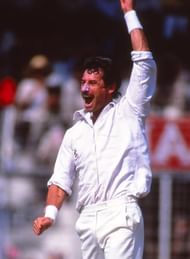
Richard Hadlee against Australia was like Hannibal against the Roman Empire. Hadlee, like McGrath, has the impressive record of never averaging over 30 against a single Test-playing nation. He took multiple fiver-fors against every country he played, but took 14 against Australia.
New Zealand first played Australia in 1946, lead by Richard Hadlee's father, Walter. New Zealand were routed for 42 and 54 by a strong Australian side, with William Brown declaring before his side even made 200.
It was not until 1973 that Australia deemed New Zealand worthy competition, and agreed to play them again. By then a young Richard Hadlee was in the team, and even though he showed signs of promise, he was helpless to stop his side falling to two innings defeats in three Tests.
As the two sides began to play more frequently, New Zealand became more competitive. Slowly, a rivalry began to form, one that was given a bit more edge when Greg and Trevor Chappell resorted to abusing the rules of the game to secure an ODI win with the infamous underarm delivery in 1981.
Therefore, by the mid 1980s, there was plenty of history between the sides. New Zealand were still waiting for their first Test series win against Australia, but with Australia struggling, and Hadlee in his prime, this was about to change.
In Brisbane Hadlee started with one of the all-time great performances, tearing through Australia with 9/52 in the first innings. Yet Hadlee's hunger for wickets wasn't sated, as in Australia's next innings he took 6/71.
Hadlee's lethal combination of pace and swing made the Australian batsmen seem nothing more than cannon fodder. Hadlee took five wickets in all but one of Australia's six innings across the three-match series. He ended with an incredible tally of 33 wickets, with the next best bowler being Robert Holland with 13.
In the wake of the series, Allan Border threatened to quit as captain, so dismayed was he at Australia's performances. Only months earlier Australia had been crushed by the mighty West India pace attack as the two sides had played two five-match series back to back. But Hadlee caused more damage on his own, in just three matches, than the combined total of the West Indies bowling attack.
#5 Imran Khan: 40 wickets at 13.95 vs India (1982/83)
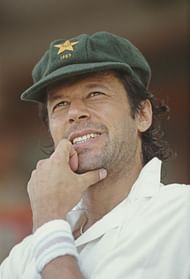
From 1982 through to 1986 Imran Khan experienced one of the finest patches of form a bowler has ever had. In these four years he took 138 wickets at just 14.31. Around the same time, Khan managed a bowling average under 20 in eight consecutive series, and the best of those was against India.
Khan's figures in the six-match series are impressive on the surface, but the more it contextualized, the better it appears. Most remarkable is that it was a tour dominated by the batsmen. There were quality bowlers in both teams, with the likes of Kapil Dev, Sarfraz Nawaz, Abdul Qadir and Dilip Doshi all taking part. Yet despite players of this quality, only Khan averaged under 30. Perhaps even more indicative of how the batters dominated the series was that five bowlers averaged over 100.
It's unsurprising then that three of the six matches in the series were drawn, with Pakistan winning the other three. In the three Pakistan won, Khan had match figures of 11/79, 11/180 and 8/80, accounting for exactly half of the Indian wickets that fell in these games. This means that even though all three of India's losses were resounding defeats, the outcome of these games could have been very different without Khan. Pakistan may have won the series with seeming ease, but Khan was the decisive factor.
Khan tended to take big wickets too. He dismissed Sunil Gavaskar and Mohinder Amarnath five times, and Dilip Vengsarkar six times. Despite this, all three of these batters had a good series, suggesting that if Khan hadn't been present they might have had a great one.
While so many statistically-impressive performances have had bowlers play in favorable conditions against weak opposition, Khan's 1982/83 series against India was the opposite. He bowled to good batsmen in conditions that no other bowler could master and still managed one of the most statistically-impressive series a bowler has had.
#4 Mitchell Johnson: 37 wickets at 13.97 vs England (2013/14)
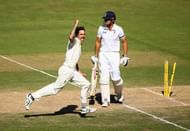
Coming through the ranks as a youngster, Mitchell Johnson was a fast-bowling prodigy. He was one of Australia's quickest bowlers when he was still in his teens, and looked destined to go down as one cricket's great bowlers.
However, as the years rolled on, Johnson continually failed to meet the lofty expectations placed upon him. He was always a decent option in ODI cricket, but in Tests he was constantly underwhelming. For the first five years of Johnson's Test career he largely disappointed, with the occasional burst of brilliance that would encourage selectors to stick with him a bit longer. That was until 2011, where Johnson only managed 13 wickets at 56.62 in a bowling attack he was meant to be leading. The selectors finally lost faith in him and dropped him from the side. By 2012, it seemed Johnson might have played his last Test.
What was rather odd was that at the same time as he was having his worst year in Tests, Johnson was thriving in ODIs. 2011 was arguably his best year in ODIs as he took 39 wickets at 20.95. Johnson's continued strong performances in ODIs led the selectors rolling the dice on him once more in Test cricket. This was perhaps as much out of desperation as anything else. Australia were facing a brilliant England side that had won the past three Ashes, the latest one having come earlier that year.
England's batting line-up included the likes of Kevin Pietersen, Ian Bell, Alastair Cook, Jonathan Trott and Matt Prior. It was a side similar to the one that won away in India a year earlier. They are still the last side to have done so.
Yet, over the course of five Tests, Johnson would dismantle this once great England side, dragging them to a 5-0 defeat.
Johnson's pace, and the awkwardness of his slinging action, saw some of the generation's best batsmen lose faith in their techniques. By the fifth Test in Sydney, only Ben Stokes, who made his debut earlier in the series, seemed to bat with any confidence as England fell for 155 and 166.
The side that entered the series as one of England's best in decades were left in tatters by Johnson.
Unlike for much of the rest of his career, Johnson showed great consistency throughout this series and indeed the series in South Africa that followed. Johnson took six wickets in every one of the five Tests against England and even took 7/40 in the first innings at Adelaide, bowling on a pitch that offered little in the way of pace and bounce.
England would rebuild and win the following Ashes series, but for a few months Johnson was able to live up to all the hype that had surrounded him since his youth.
#3 Harbhajan Singh: 32 wickets at 17.03 vs Australia (2001)
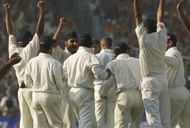
The 2001 three-match series between India and Australia deserves to be recognized as one of the most entertaining series in the past few decades. It certainly contained one of the great Tests as VVS Laxman and Rahul Dravid's extraordinary partnership in Kolkata provided a twist of which M Night Shyamalan would have been proud. But this Test can be seen as a microcosm of the entire series. Australia started strong only for India to bounce back and deny them in dramatic fashion.
Australia went into the series having won 15 consecutive Test matches. In the decade before that they had achieved incredible feats and yet it had been over 30 years since they last won a series in India. They may have believed this to be the moment.
But India had a fine side themselves. They had a batting line-up that would become the envy of the cricketing world, as well as some exciting young bowlers. Among these bowlers was Harbhajan Singh, an off-spinner who was only 20 years of age.
Harbhajan had already been in and around the Test side for a couple of years, but he was yet to make a truly telling contribution. Going into the series he had never taken more than three wickets in an innings. This would change in the very first match as Harbhajan took 4/121 in the first innings. But Australia still comfortably won by 10 wickets, securing their 16th consecutive Test match win. All looked to be going to plan for Australia, but then Harbhajan happened.
Australia started the second Test equally well, forcing India to follow-on with a 274-run lead, although Harbhajan had already begun to weave his magic. In the first innings he not only took a hat-trick that included the wickets of Ricky Ponting, Adam Gilchrist and Shane Warne, but he finished with figures of 7/123, ensuring Australia were limited to 445.
After Laxmann and Dravid's 376-run partnership, there was still work to do as the target of 384 set for Australia did not mean certain victory. But Harbhajan struck again, taking 6/73 and ensuring India leveled the series.
Harbhajan than carried his form over to the third and final Test. He took 7/133 in the first innings and then 8/84 in the second as India edged home by two wickets.
India, therefore, continued to reign supreme at home. Harbhajan had taken 32 of the 50 wickets Australia lost on the tour, and dismissed Ponting in all five of his innings with the Australian finishing the series with an average of 3.40. His rival spinner, Shane Warne, only managed 10 wickets at 50.50.
Like Hadlee in 1985, Harbhajan hardly needed the help of the other bowlers to decimate the Australian batsmen. But here Australia had one of the strongest sides they had fielded in history and yet still were no match for Harbhajan.
#2 Rodney Hogg: 41 wickets at 12.85 vs England (1978/79)
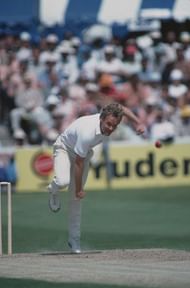
If the 2001 team to tour India was one of the strongest in Australia's history, then the side that traveled for the 1978/79 Ashes was probably one of their weakest. World Series Cricket had removed almost the entirety of Australia's first eleven from the side and simultaneously exposed a lack of depth in the team. England had also lost some of their key players to the WSC's Rest of the World XI, but still fielded a team that included Geoff Boycott, Graham Gooch, David Gower, Ian Botham and Bob Willis.
The very first session of the series saw Australia slip to 6/26 and the tone was set there. England won the six match series 5-1, which is still their biggest win in Ashes history. Making England's win all the more impressive was that the series was played in Australia, and that all five of their wins were by resounding margins.
It is hard to fathom then that there was a player who had arguably the greatest series an Australian cricketer has had since Bradman. It is even more difficult to fathom that this player was someone who didn't even make his domestic debut until he was 24, his Test debut in the first Test of this series and someone who would never take more than 11 wickets in a series again.
Simply put, Australia could not have had a more unlikely hero than Rodney Hogg. Coming into the series, Hogg seemed like another passable state cricketer who had found himself in a flailing Australia side due to the team's absentees. However, after a few matches, Hogg looked like the lovechild of Fred Spofforth and a bolt of lightning.
Hogg was exceptionally quick, but also had a great deal of control. Match after match he ran through the England batting line-up, taking four or more wickets in seven of the eleven innings in which he bowled. In the lone game Australia won, Hogg ended with the figures of 10/66.
It is down to Hogg, and Hogg alone, that despite winning the series and five of the matches so emphatically, England never scored more than 360. It is difficult to imagine how disastrous the series would have been for Australia had they not called up his services, despite his selection for the series not even being a guarantee.
As the likes of Lille and Thompson returned, and his body began to betray him, Hogg would have to settle for being a peripheral figure in the Australian squad. Hogg would never reach the heights he did in his debut series, and would only manage to take one more five-for in his career. But for one summer Hogg was the pinnacle of pace bowling, the best Australia had seen in arguably the worst side they had seen. Hogg's 1978/79 Ashes was a miracle wrapped in a tragedy.
#1 Jim Laker: 46 wickets at 9.61 vs Australia (1956)
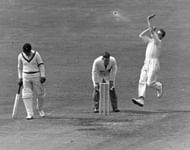
For the first half of his career, Jim Laker was a rather unremarkable bowler. While he was successful at county level, he was inconsistent when picked for England, and found himself in and out of the national team for the best part of the decade.
But it might not have solely been his inconsistent performances that led the selectors to doubt him as Laker had a rather uninspiring bowling action. Laker bowled his off-breaks in a very round-arm manner, and seemed to come to almost a complete halt at the crease, with barely any follow-through.
England also had plenty of quality players to pick from at this time. 1953 saw them win the Ashes for the first time post World War 2. They then went one better and won 3-1 in Australia in 1954-55, with Laker taking no part in the series.
However, by 1956, Australia had a formidable blend of young and old talent, with the likes of Keith Miller, Neil Harvey, Ray Lindwall, Alan Davidson and Richie Benaud in their side.
Laker, meanwhile, had only played one Test in just under two years, but the English selectors decided to give him one more chance. This proved to be a rather good decision.
Laker started strongly, taking 4/58 and 2/29 in the rain-effected first Test. He played well again in the second Test, but only managed three wickets as Australia took a 1-0 lead. At the time, England fans probably weren't too optimistic. While they had won the previous two Ashes, Keith Miller was looking deadly and Australia's overabundance of all-rounders meant they batted incredibly deep with Alan Davidson actually batting at 11 in the first Test.
However, what Laker would achieve in the games to follow were performances the likes of which had never been seen in cricket before, and haven't been seen since.
Laker took 30 wickets in the next two Tests alone, taking 11/113 at Headingly, and then following up with a record 19/90 at Old Trafford. In two Tests Laker had taken more wickets than he had taken in any of his eight years in Test cricket and twice as many as the next best English bowler would take in the entire series.
Laker's 19/90 remains one of the most extraordinary Test cricketing records to date. In a single game he managed what are still the first and fourth best bowling figures in an innings in Test cricket history. Furthermore, this was on a pitch the Australian spinners took a combined total of 6/274.
About half a century later, Neil Harvey described the ball Laker dismissed him with in the first innings to be Shane Warne to Mike Gatting in reverse.
Weather interfered again when it was time for the final Test, but Laker still managed to take seven wickets to lift his series tally to 46. Had so much of the series not been lost to rain, or had it been a six-match series, Laker would almost definitely have become the first bowler to take 50 wickets in a series.
Laker's 1956 Ashes was obscenely good. He didn't just defeat the Australian batsmen, but also cricket logic.
Follow IPL Auction 2025 Live Updates, News & Biddings at Sportskeeda. Get the fastest updates on Mega-Auction and cricket news
